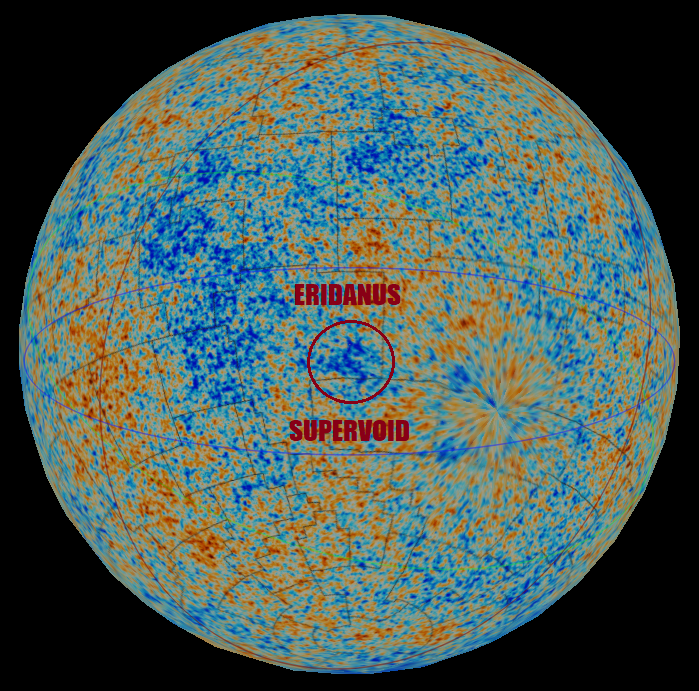 |
When displayed on a celestial sphere, the CMB cold spot can be seen to correspond with the Eridanus supervoid, but the full extent and depth of the void is only just beginning to be quantified today. It’s plausible that the reason this spot is so cold is due to the gravitational influence of the shrinking supervoid over time. (Credit: Piquito veloz/Celestia) |
KEY TAKEAWAYSOn the largest scales, the Universe is supposed to be isotropic and homogeneous: the same everywhere and in all directions.Because the Universe has tiny, 1-part-in-30,000 imperfections imprinted on it, we expect to see a pattern of cold-and-hot spots in the leftover radiation from the Big Bang: the Cosmic Microwave Background.But one spot in the Universe, called the "CMB cold spot," is an anomaly that we couldn't explain. At last, it's all fallen into place.
OUR UNIVERSE IS NORMAL!
Its biggest anomaly, the CMB cold spot,
is now explained
The Universe is supposed to be the same
everywhere and in all directions.
So what's that giant "cold spot" doing out there?
by Ethan Siegel
February 1, 2022
Since the discovery of the Cosmic Microwave Background (CMB) nearly 60 years ago, scientists have been searching for a hint — any hint — of a crack in the façade of the hot Big Bang. At every step along the way, as our instruments became more sensitive and our observational reach extended farther than ever before, the Big Bang’s predictions were borne out in spectacular fashion, one after another.
The Universe’s expansion and how that expansion changed over time was measured, and found to be precisely consistent with the expanding Universe predicted by physical cosmology. The spectrum of the CMB was measured, confirming it was the most perfect blackbody ever seen in the Universe. The initial cosmic abundances of the light elements and their isotopes were determined, and found to be in direct agreement with the predictions of Big Bang nucleosynthesis. And the formation of large-scale structure and the growth of the cosmic web matched the Big Bang’s predictions without exception.
But with the launches of WMAP and Planck, the small-scale imperfections in the CMB were measured, and one anomaly stood out: a cold spot that simply couldn’t be explained based on the Universe we knew. At last, that mystery may finally be solved, as the culprit has been identified at long last: the largest supervoid in the nearby Universe. If this research holds up, it teaches us that our Universe is normal, after all, and that the CMB cold spot isn’t an anomaly at all.
 |
The initial fluctuations that were imprinted on our observable universe during inflation may only come into play at the ~0.003% level, but those tiny imperfections lead to the temperature and density fluctuations that appear in the cosmic microwave background and that seed the large-scale structure that exists today. Measuring the CMB at a variety of cosmic locations would be the only feasible way to disentangle the intrinsic dipole of the CMB from that induced by our motion through the Universe. (Credit: Chris Blake and Sam Moorfield) |
The fact that the CMB is so perfect is, itself, a modern wonder of the Universe. Everywhere we look, in all directions, it’s plain to see just how different the Universe is from place to place. Some regions of space are extremely rich in structure, with scores, hundreds, or even thousands of large galaxies all collected into the same gravitationally bound structure. Other locations have galaxies, but they’re relatively sparsely located in small groupings and collections scattered about through space. Still other places have only isolated galaxies. In the least dense locations, there are no galaxies to be found at all for volumes that span tens or even hundreds of millions of light-years on a side.
And yet, the theory of the Big Bang comes along with an inextricable prediction: that in the earliest stages of the hot Big Bang, the Universe must have been both isotropic, or the same in all directions, and homogeneous, or the same in all locations, to a tremendous degree of precision. It can only come into existence with tiny, minuscule imperfections, or regions of slightly greater-or-lesser density than average. It’s only because of the tremendous amount of cosmic time that passes — and the relentlessly attractive nature of the gravitational force — that we have a rich, structure-filled Universe today.
 |
The formation of cosmic structure, on both large scales and small scales, is highly dependent on how dark matter and normal matter interact. The distributions of normal matter (at left) and dark matter (at right) can affect one another, as things like star formation and feedback can affect the normal matter, which in turn exerts gravitational effects on the dark matter. The seed overdense and underdense fluctuations allowed this cosmic web of structure to arise. (Credit: Illustris Collaboraiton/Illustris Simulation) |
The Cosmic Microwave Background was discovered back in the mid-1960s, and the early goals were to:
- measure the amount of radiation emitted at different frequencies,
- measure the peak of its temperature,
- determine whether it was truly a perfect blackbody, as predicted, or whether it was better approximated as the sum of a series of blackbodies (which is a property of starlight),
- to figure out the nature of the interfering emission from our galaxy,
- and to test whether it truly had the same properties everywhere and in all directions.
Over time, we were able to refine our measurements. Initially, the CMB was announced to be at 3.5 K, which then was revised to 3 K, then 2.7 K, and a little later, a third significant figure was added: 2.73 K. In the mid-to-late 1970s, a small, 1-part-in-800 imperfection was discovered: an artifact of our own motion through the Universe.
It wasn’t until the 1990s that the first primordial imperfections were found, coming in at about the 1-part-in-30,000 level. At last, we had the observational evidence to not only confirm a Big Bang-consistent origin for the CMB, but to measure what sort of imperfections the Universe itself began with.
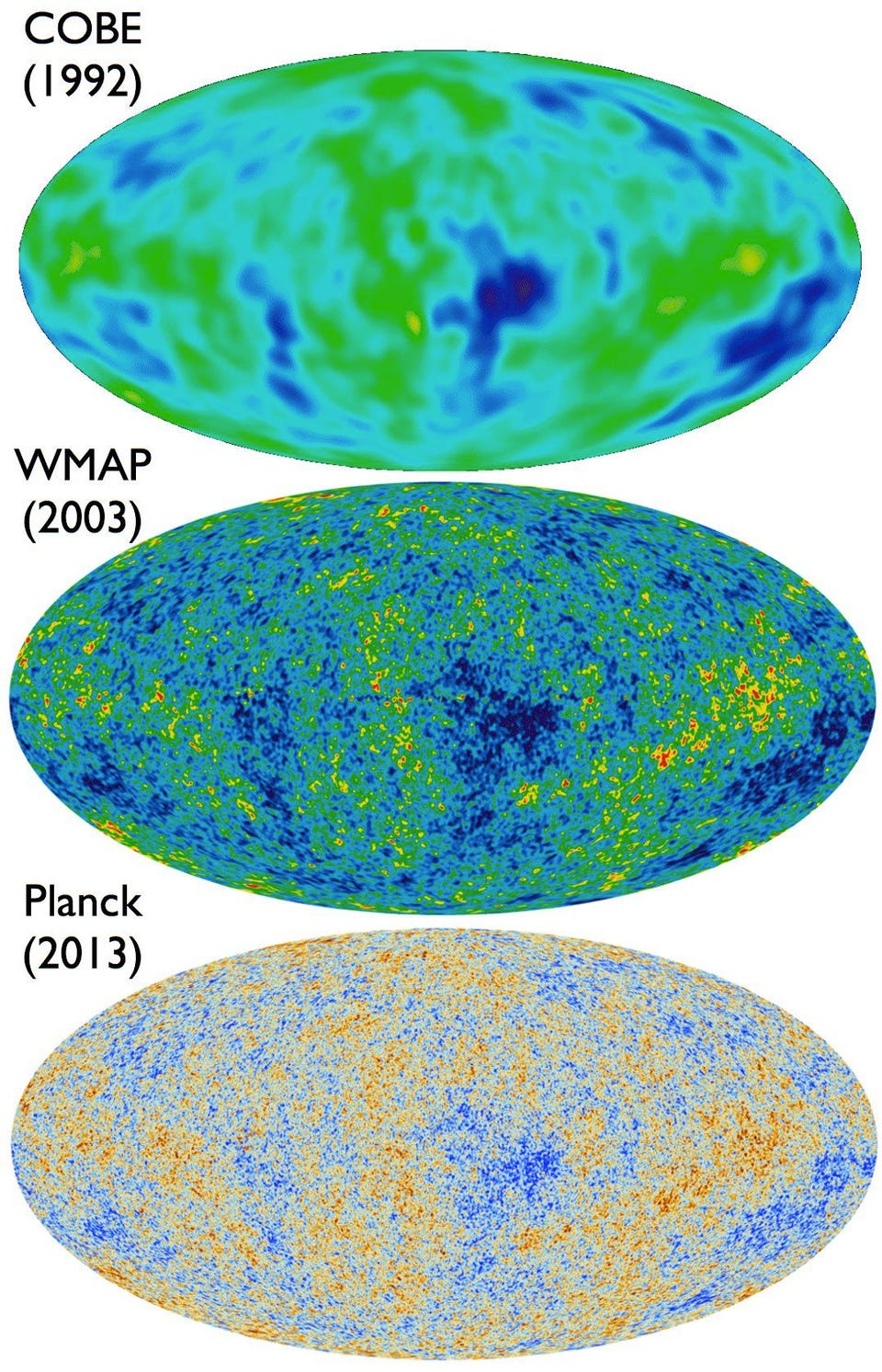 |
COBE, the first CMB satellite, measured fluctuations to scales of 7º only. WMAP was able to measure resolutions down to 0.3° in five different frequency bands, with Planck measuring all the way down to just 5 arcminutes (0.07°) in nine different frequency bands in total. All of these space-based observatories detected the Cosmic Microwave Background, confirming it was not an atmospheric phenomenon, and that it had a cosmic origin. (Credit: NASA/COBE/DMR; NASA/WMAP science team; ESA and the Planck collaboration) |
You see, the hot Big Bang, although it was the beginning of our observable Universe as we know it, wasn’t the very beginning of everything. There’s a theory that’s been around since the early 1980s — cosmic inflation — that posits a set of properties that the Universe possessed prior to the start of the hot Big Bang. According to inflation:
- the Universe wasn’t filled with matter or radiation, but a new form of energy inherent to the fabric of space itself,
- that energy caused the Universe to expand at a rapid and relentless pace,
- stretching a region of space no larger than the Planck length to greater than the scale of the observable Universe something like every ~10-32 seconds,
- and then inflation ends, dumping that energy-inherent-to-space into particles (and antiparticles) for the first time, triggering the hot, dense, uniform, but rapidly-expanding conditions we identify with the hot Big Bang.
The only reason the Universe isn’t perfectly, absolutely uniform everywhere is because the tiny fluctuations inherent to quantum physics, during this epoch of rapid expansion, can get stretched across the Universe, creating the overdense and underdense seeds of structure. From these initial seed fluctuations, the entire large-scale structure of the Universe can arise.
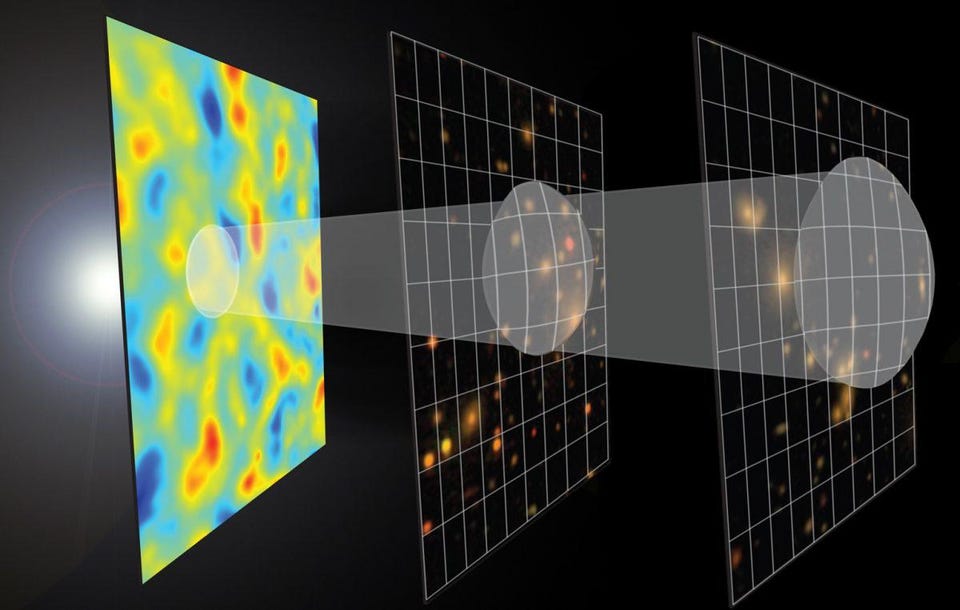 |
The cold spots (shown in blue) in the CMB are not inherently colder, but rather represent regions where there is a greater gravitational pull due to a greater density of matter, while the hot spots (in red) are only hotter because the radiation in that region lives in a shallower gravitational well. Over time, the overdense regions will be much more likely to grow into stars, galaxies and clusters, while the underdense regions will be less likely to do so. However, the CMB cold spot is anomalously cold, inconsistent with an origin at the last-scattering surface. (Credit: E.M. Huff, SDSS-III/South Pole Telescope, Zosia Rostomian) |
According to the theory of inflation, there should be a very specific set of fluctuations that the Universe starts with at the onset of the hot Big Bang. In particular:
- the fluctuations should be Gaussian, which means they should follow a Bell Curve-like distribution about some average,
- they should be approximately the same amplitude on all scales, with larger cosmic scales having slightly greater fluctuations by only a few percent than the smaller ones,
- these fluctuations should all be adiabatic (with constant entropy) in nature, with none of them being isocurvature (the other option) in nature,
- and that as the Universe expands, these fluctuations should begin to gravitationally collapse on small scales first, with larger scales only catching up once the cosmic horizon has grown to a certain size.
All of these predictions have since been borne out and confirmed by observations, some to within the limits of our measurement precision and others quite spectacularly.
 |
The fluctuations in the CMB are based on primordial fluctuations produced by inflation. In particular, the ‘flat part’ on large scales (at left) have no explanation without inflation. The flat line represents the seeds from which the peak-and-valley pattern will emerge over the first 380,000 years of the Universe, and is just a few percent lower on the right (small-scale) side than the (large-scale) left side. (Credit: NASA/WMAP science team) |
However, it’s always worth looking for anomalies, as no matter how thoroughly your predictions agree with reality, you must always put ahead, hoping to uncover something unexpected. After all, it’s the only way you can discover something new: by looking as you’ve never looked before. If you have specific predictions and expectations for what your Universe is going to look like, then anything that defies your expectations is — at the very least — worth a second look.
Perhaps the most unusual remaining feature that we see in the microwave sky, once we subtract out the effect of the Milky Way galaxy, is the fact that there’s a cold spot that doesn’t align with these theoretical explanations. Once we’ve quantified the types and scales of temperature fluctuations that ought to exist, we can correlate them together, and see how fluctuations on smaller and larger scales should be related.
In one particular region of space, we find that there’s a very deep cold spot: about 70 microkelvin below the average temperature on a relatively large angular scale. Moreover, that cold spot appears to be encircled by a hotter-than-average region, making it even more anomalous. To many, the cold spot in the CMB represented a potential challenge to inflation and the standard cosmological model, as it wouldn’t make sense if the Universe was somehow born with this anomalously low-temperature region.
 |
The quantum fluctuations that occur during inflation get stretched across the Universe, and when inflation ends, they become density fluctuations. This leads, over time, to the large-scale structure in the Universe today, as well as the fluctuations in temperature observed in the CMB. Its a spectacular example of how the quantum nature of reality affects the entire large-scale universe. (Credit: E. Siegel; ESA/Planck and the DOE/NASA/NSF Interagency Task Force on CMB research) |
It’s important to recognize where these temperature fluctuations come from in the first place. The Universe, even at the start of the hot Big Bang, really is the exact same temperature everywhere. The thing that’s different from location to location is the density of the Universe, and this is the component that has those 1-part-in-30,000 imperfections, as imprinted by inflation. The reason we observe the Universe to possess different temperatures in different regions of space is because of the phenomenon of gravitational redshift: matter curves space, and where space is more severely curved, light has to lose more energy to “climb out” of that gravitational potential well. In the astrophysics community, this is known as the Sachs-Wolfe effect, and it’s the primary cause of the temperature differences we observe in the CMB.
But there’s another, more subtle effect: the integrated Sachs-Wolfe effect. As structure forms in the Universe, as gravitation brings more and more mass together, as clusters grow and voids form, and as the relative ratios of radiation, matter, and dark energy change with respect to one another, the gravitational effects of traveling into a certain region of space don’t necessarily equal the gravitational effects of traveling out of that same region of space later on. The Universe evolves, structures form and become more matter-rich in some areas and more matter-poor in others, and any light passing through those regions is affected.
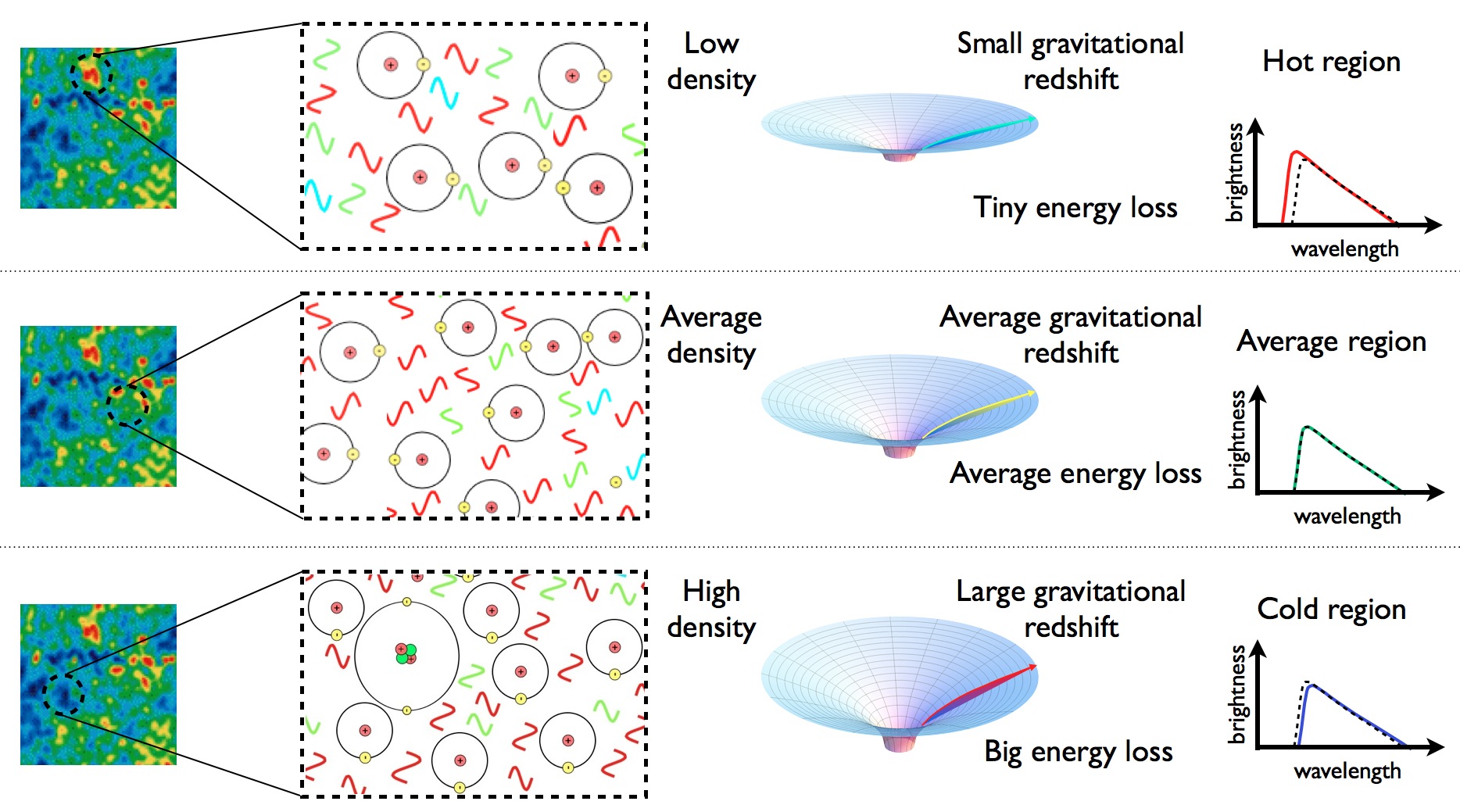 |
|
Imagine, if you will, that you have two different regions of space: a large-scale overdensity (like a supercluster) and a large-scale underdensity (like a great cosmic void). Now, imagine, just like in our real Universe, you have some form of dark energy: a component of the Universe that behaves differently from matter, and doesn’t dilute in density as the Universe expands. Now, let’s imagine what happens as the photon, traveling through space, encounters either a big overdensity or a big underdensity.
As the photon begins to see this overdensity (underdensity), it gains (loses) energy as it travels from an average region of space into the new region that departs significantly from the average density.
But owing to dark eergy, the gravitational potential well (hump), whether positive or negative, becomes stretched out and gets more shallow, and does so as the photon travels through it.
As a result, when the photon exits the overdense (underdense) region, it re-loses (or re-gains) a smaller amount of energy than it gained (lost) when it first entered that region.
If something appears anomalously cold in the CMB, it could be because there’s something wrong with our model of the Universe; that’s of course the more interesting option. But it could also be, quite simply, because there’s a large cosmic void in that location, and that void grew shallower as the light traveled through it because of dark energy.
 |
The anomalous cold spot in the CMB, as viewed by Planck, is unusual not only for its coldness and its extent, but for the fact that it’s surrounded by a hot region on all sides. This puzzling feature may be explicable by the recent discovery of a new, nearby supervoid in the constellation of Eridanus. (Credit: A. Kovács et al., 2021, MNRAS) |
Now, here’s where the idea becomes testable: you can’t point to a void that’s too far away along the line-of-sight to explain it, because dark energy only becomes important for the Universe’s expansion over the past ~6 billion years or so. If one exists along this line-of-sight, it must be closer, at present, than 7.5 billion light-years.
So, what do we find when we go out and look?
That’s where the latest results from the Dark Energy Survey come in. Scientists were able to confirm that, yes, there is a supervoid there, and it may have a much higher-amplitude integrated Sachs-Wolfe effect that a typical underdensity does. While some underdensities were previously found at greater distances some 6-10 billion light-years away, they were determined to account for no more than ~20% of the effect. However, a 2015 study revealed a nearby supervoid right in that precise direction: 1.9 billion light-years away and about 0.5-1.0 billion light-years across. The most recent study that confirms this void and measures its properties, finds that it’s the largest supervoid that exists since the onset of dark energy’s dominance. The study suggests — but doesn’t yet prove — that there is a causal relation between this late-time supervoid and the “cold spot” in the CMB.
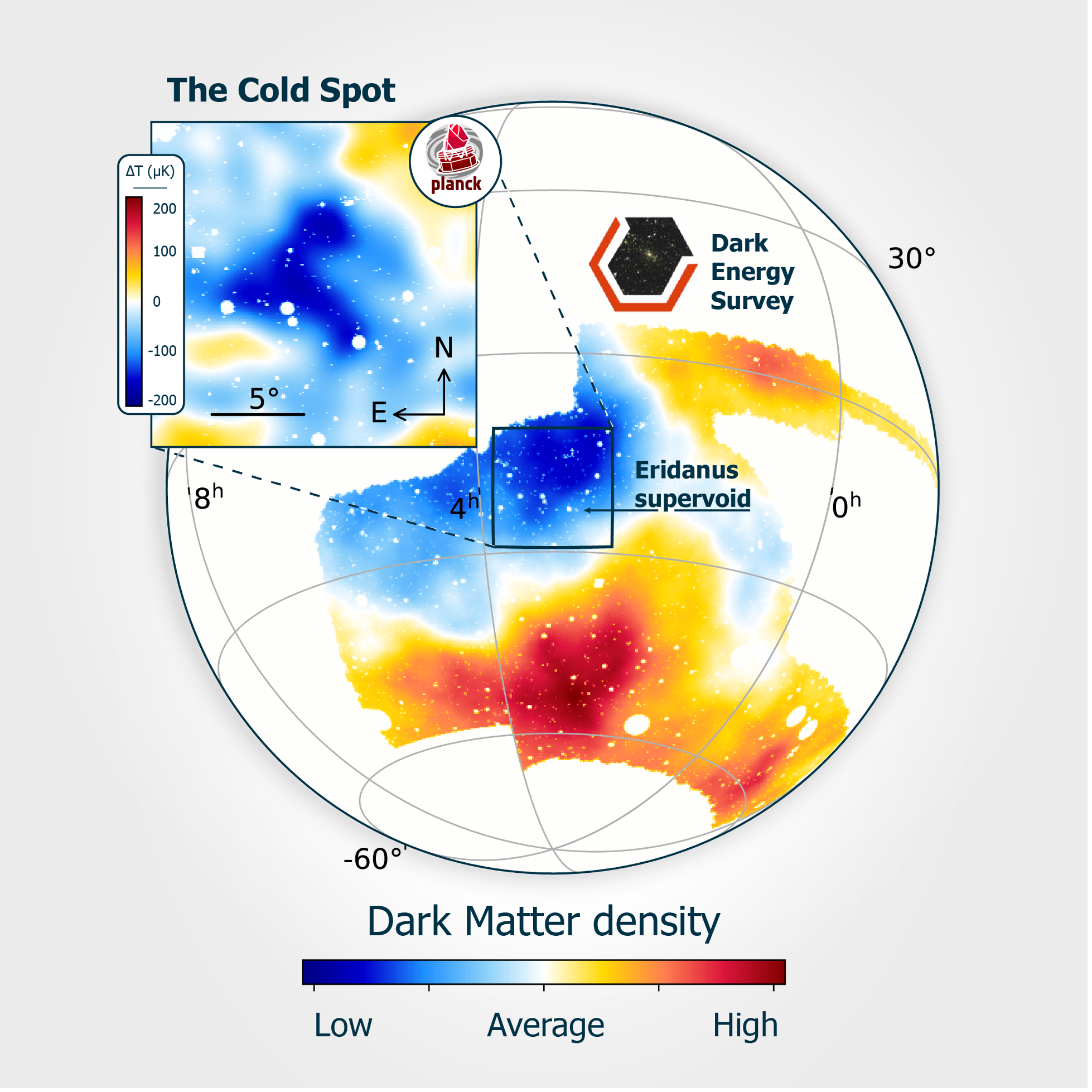 |
The Cold Spot resides in the constellation Eridanus in the southern galactic hemisphere. The inset shows the microwave temperature map of this patch of sky, as mapped by the European Space Agency Planck satellite. The main figure depicts the map of the dark matter distribution created by the Dark Energy Survey team. Note how the large supervoid thoroughly coincides with the CMB’s cold spot. (Credit: Gergö Kránicz and András Kovács) |
There are many different ways to map out the large-scale structure of the Universe: from galaxy counts to gravitational lensing to the overall impact that the structure has on the background light emitted from various redshifts. In this particular case, it was the construction of a gravitational lensing map that confirmed the presence of this supervoid, which happens to be the emptiest large region of space in our nearby corner of the Universe. We cannot say for certain that this supervoid explains the full extent of the CMB cold spot, but it’s looking more and more likely that, once the presence of the supervoid is taken into account, what remains is no more anomalous than any other typical region of the sky.
The way we’ll tell for sure, of course, is through better, deeper, higher-resolution imaging of this relatively large region of the sky, which spans somewhere around 40 square degrees. With the ESA’s Euclid mission poised to launch just next year, in 2023, and with the Vera Rubin Observatory and NASA’s Nancy Grace Roman Telescope expected to come online over the next few years, the critical data will soon be in our hands. After nearly two decades of wondering at what could have caused the CMB cold spot, we finally have our answer: the largest supervoid in the nearby Universe. All we need is a robust confirmation of what the present data strongly indicates, and this will be yet another cosmic challenge to which our standard cosmological model is thoroughly capable of rising.
No comments:
Post a Comment